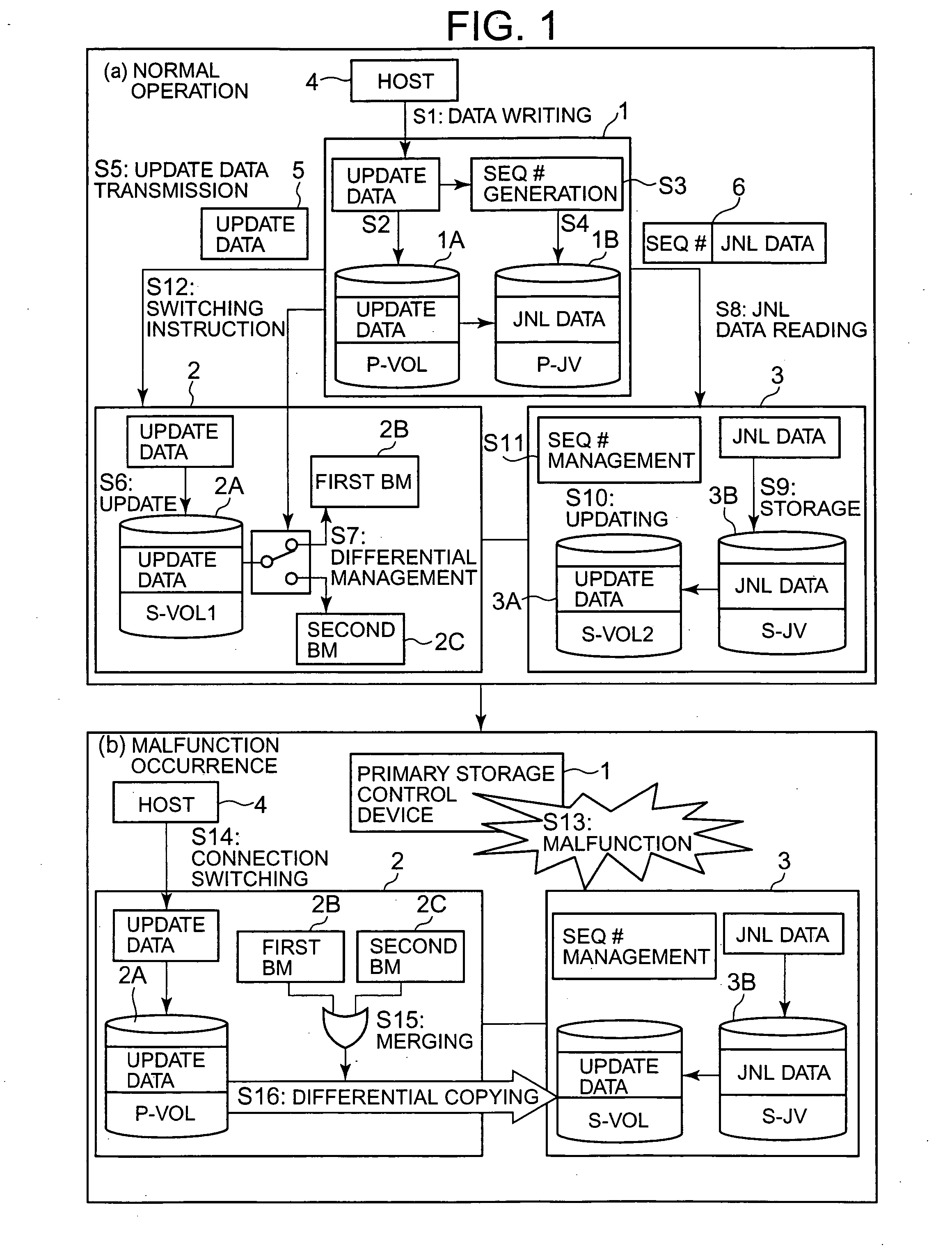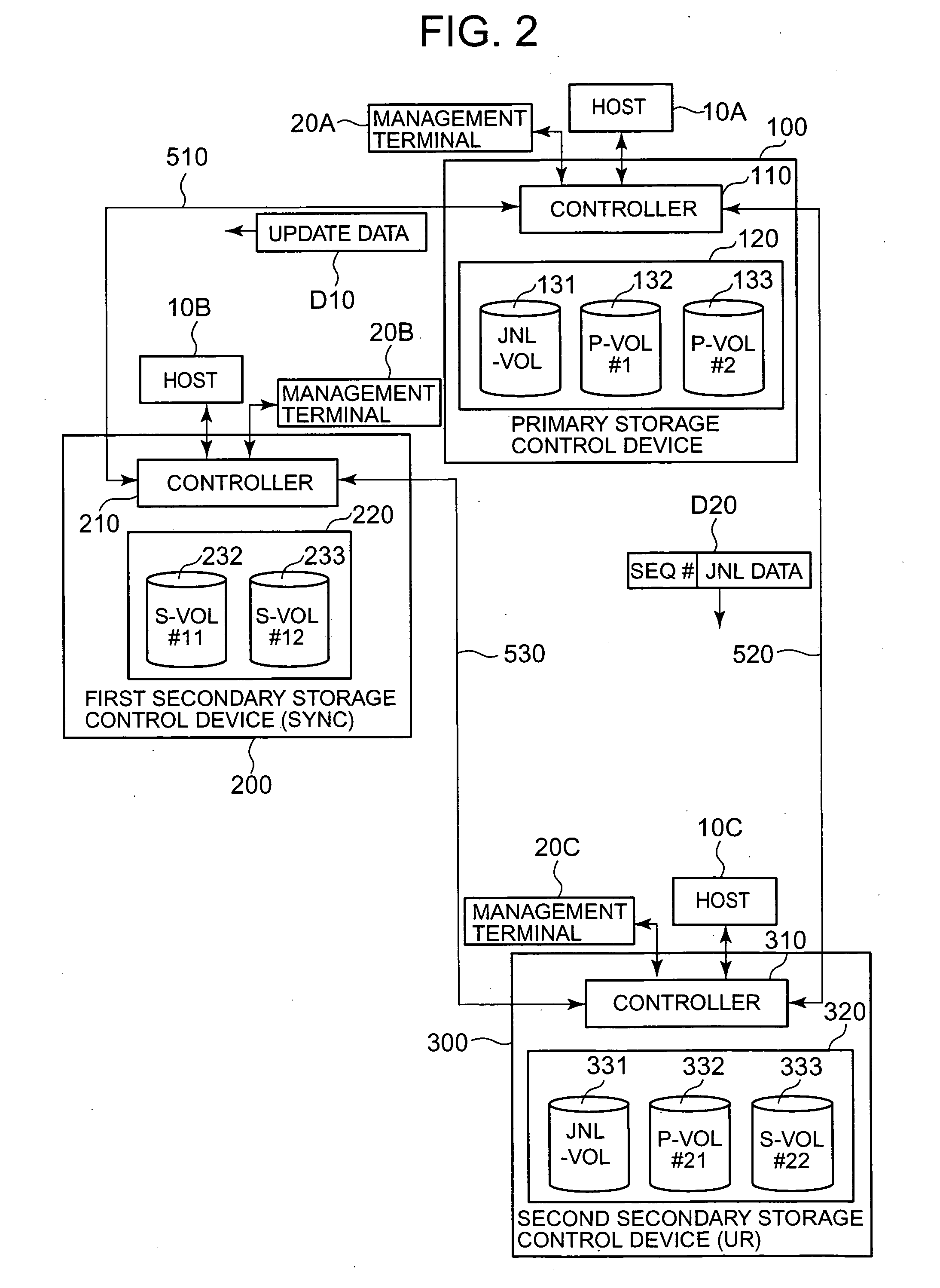Storage system and storage system management method
a storage system and management method technology, applied in error detection/correction, redundancy hardware error correction, instruments, etc., can solve the problems of increased structural complexity, data processing services cannot be provided to hosts, and the load of one secondary storage control device is increased, so as to reduce the storage capacity to store correspondence relations, reduce the amount of storage, and reduce the switching time
- Summary
- Abstract
- Description
- Claims
- Application Information
AI Technical Summary
Benefits of technology
Problems solved by technology
Method used
Image
Examples
embodiment 1
[0069]FIG. 2 shows the overall configuration of a storage system of this invention. The correspondence relations with FIG. 1 are as follows. The primary storage control device 100 corresponds to the primary storage control device 1 in FIG. 1; the first secondary storage control device 200 corresponds to the first secondary storage control device 2 in FIG. 1; the second secondary storage control device 300 corresponds to the second secondary storage control device 3 in FIG. 1; and the host 10A corresponds to the host 4 in FIG. 1.
[0070] This storage system can be configured comprising one or more primary storage control devices 100, a plurality of secondary storage control devices 200, 300, hosts 10A, 10B, 10C, and management terminals 20A, 20B, 20C. At least a portion of the hosts 10A, 10B, 10C and management terminals 20A, 20B, 20C may be the same. For example, the hosts 10A and 10B, and the management terminals 20A and 20B, may respectively be the same devices.
[0071] During norma...
embodiment 2
[0172] A second embodiment of the invention is explained, referring to FIG. 20. The following embodiments, including this embodiment, are equivalent to modified examples of the first embodiment. In this embodiment, four storage control devices are used to enhance the redundancy of the storage system.
[0173] In FIG. 20, (a) shows the state during normal operation. In this storage system, in addition to the primary storage control device 100, first secondary storage control device 200, and second secondary storage control device 300, a third secondary storage control device 400 is provided.
[0174] As explained in the first embodiment, the primary storage control device 100 and first secondary storage control device 200 are connected by a synchronous method, and the primary storage control device 100 and second secondary storage control device 300 are connected by an asynchronous reading method.
[0175] (b) in FIG. 20 shows a case in which a malfunction or similar has occurred in the pr...
embodiment 3
[0178] A third embodiment is explained using FIG. 21. In this embodiment, the correspondence relations between the storage control devices 100, 200, 300 are not held by the storage control devices 100, 200, 300, but the secondary storage control devices 200 and 300 each hold only the correspondence relation with the primary storage control device 100.
[0179]FIG. 21 is a flowchart showing a portion of the processing executed by the storage system of the third embodiment. This flowchart corresponds to the flowchart of FIG. 18, and includes common steps. Here explanations of the common steps are omitted, and the characteristic steps are mainly explained.
[0180] After S79, the host 10B issues a request for transmission of pair confirmation information to the second secondary storage control device 300 (S101). Pair confirmation information is information used to confirm the correspondence relation between the first secondary data volumes 232, 233 and the second secondary data volumes 332...
PUM
 Login to View More
Login to View More Abstract
Description
Claims
Application Information
 Login to View More
Login to View More - R&D
- Intellectual Property
- Life Sciences
- Materials
- Tech Scout
- Unparalleled Data Quality
- Higher Quality Content
- 60% Fewer Hallucinations
Browse by: Latest US Patents, China's latest patents, Technical Efficacy Thesaurus, Application Domain, Technology Topic, Popular Technical Reports.
© 2025 PatSnap. All rights reserved.Legal|Privacy policy|Modern Slavery Act Transparency Statement|Sitemap|About US| Contact US: help@patsnap.com



